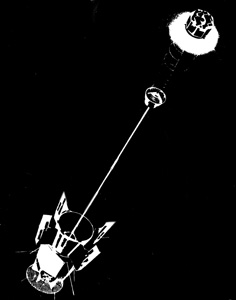The SNAP 9A satellite burnup dispersed almost pure 238pu into the atmosphere over the Mozambique channel at about 25°S latitude in 1964.
In April 1964 a Snap 9A nuclear power generator aboard a satellite reentered the atmosphere and burned up following a malfunction during launch. The generator contained about 17 kCi of 238pu but only 13 Ci of 239pu. For comparison, some 400 kCi of 239Pu have been dispersed into the air by all nuclear explosions, and the total amount of 238pu deposited from the accidental stratospheric abortion of this satellite was about twice the amount of 238pu from all nuclear weapons testing. The satellite was estimated to have entered the atmosphere of the southern hemisphere above the Mozambique channel (about 25°S latitude) at an altitude of about 45000 meters. Pu in the device was assumed to have completely ablated during the heat of reentry and to have been distributed in the atmosphere as particles of unknown size distribution.
In 1964, a rocket failed to boost Transit 5BN-3 with a SNAP-9A, RTG into orbit. It « burned up during re-entry and ablated into small particles » together with its approximately 1 kilogram of Plutonium-238.

For several years after the reentry, research programs were carried out to characterize the fate of the Pu debris. Studies showed that some 73% of the 238Pu was deposited in southern hemisphere, and 27% in northern hemisphere. Soil cores from a wide range of latitudes revealed the depositional pattern [2, Table 1, Fig. 1]. The average weapons 238pu/239,24opu ratio was found to be .024 in soils collected before fallout from SNAP 9A. SNAP 9A 238pu increased this ratio in northern hemisphere soils to .036, and to above 0.1 in southern hemisphere soils. The 238Pu rich debris reached maximum concentrations in ground level air 2-3 years later, depending upon latitude, and by 1971 was largely depleted from the atmosphere [1]. The SNAP derived 238Pu became evident in surface air at 46°N at Richland, Wa. USA in spring of 1966 [2, Fig. 2]. The 238pu/239,240Pu ratio increased suddenly to .042 from the ratio of 0.020 which it had averaged from 1962-5 when the Pu came primarily from U.S. and U.S.S.R atmospheric nuclear weapons tests [1]. SNAP 9A derived 238Pu also caused a sharp increase in activity of this isotope deposited in ice layers deposited in 1965-66 on both the Antarctic and Greenland ice caps [3,4, 5; Figs. 3 and 4]. The SNAP Pu pulse lasted only a few years. By 1982 the 238pu/239,24opu ratio in global fallout had declined to .0254 and did not differ significantly between hemispheres.
